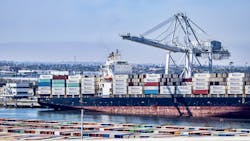The number of ocean containerships stuck off U.S. ports is shocking and unprecedented. Lag times these ships must wait for berths are setting records. But those are only the most visible reminders—what’s brought the supply chain crisis from “the boardroom to the living room”—of problems all along the chain, two experts noted during a Nov. 9 webinar.
The whole supply chain has a “velocity problem,” said David Arsenault, president of GSC Logistics Inc., a port trucking giant and participant in the webinar, “International Freight & Port Congestion: The Impact on Domestic Freight,” sponsored by the Truckload Carriers Association. ,
“Having been in the supply chain for 35-plus years, [it’s] been out of sight, out of mind until the pandemic,” said Glenn Jones, global VP of product strategy and marketing for Blume Global, who also joined the webinar. Since COVID-19’s onset in 2019, the chain has gone from “the boardroom to the living room” in the amount of attention that it’s received, he said.
Arsenault noted that the congestion at ports is caused by inefficient operations such as loading and unloading slowdowns and hours of operation, yes, but also issues downstream in the supply chain—warehouses and fulfillment centers still understaffed because of the pandemic, over-the-road and drayage truck driver shortages, a lack of chassis, and longer dwell times at terminals.
A supply chain unprepared for the ecommerce boom
The crisis also is just as much the result of a system that has had to face—at the onset of COVID-19 and beyond—the “stress test” of record cargo imports as the ecommerce economy went from annual 3% to 5% growth to a 20% increase in 2020, Arsenault said. The trend continues into 2021.
“Ecommerce puts on a different set of challenges,” he said. “It’s a byproduct of the pandemic that is going to continue post-pandemic.”
Arsenault kicked off the webinar by citing statistics about the gravity of the logjam at many U.S. ports—not just the Ports of Los Angeles and Long Beach, the two largest shipping gateways in the U.S.
The Port of Virginia is experiencing traffic surges after work there to dredge that port, the Port of Savannah, Georgia, has an average of 20 ships a day waiting for berths, the ports in Seattle and Tacoma both are “disrupted” with an average daily logjam of a dozen ships, and backups are starting at the Ports of Houston and New York and New Jersey. Some ports, such as the Port of Oakland, are starting to surge services to ocean carriers to ease the congestion, particularly at L.A. and Long Beach.
But, Arsenault said, the major California ports are a clear focus because they handle 40% of all the goods that come in and go out of the U.S. The Port of Los Angeles is averaging 70 containerships a day anchored off-port waiting to unload, he said, and the average wait time for a berth there is 13 days, he added.
At the ports generally, containers used to have an average of a three- to four-day turnaround. Now the average is eight to nine days, he said.
The problem at the ports has only gotten worse since the summer, another fleet expert reported this week.
Don Ake, FTR Transportation Intelligence’s VP of commercial vehicles, said that in September, there were more than 40 ships backed up at U.S. ports. “We thought that was very bad,” Ake noted. “But now, there are 100 ships waiting at ports as of Oct. 19. So, we went from 40, which we thought was bad, last month to 100, and then to make it worse, there were 45 more ships on the way that they expected to arrive later that week.”
While the wait at ports grows, Los Angeles and Long Beach are charging carriers $100 per day for each container not unloaded past its designated due date, for excessive dwell times. This, Ake said, is the government and the ports’ way of trying to slow the number of ships showing up.
“That strategy has its faults because if you’ve got a containership loaded in China and people have ordered that merchandise, they want that merchandise as soon as possible,” he explained. “That means you’re going to have to come over to the port and get in line. So, what we have is a big mess. And it doesn’t look like it’s going to get resolved soon.”
The problems outside the ports
Back at the Nov. 9 webinar, Arsenault said, “There’s a lot of finger-pointing going on” up and down the supply chain.
And, he said, misunderstandings have cropped up surrounding the request by President Biden for the ports to operate around the clock, seven days a week. He said marine terminals already operate 24/7, as does on-dock rail service. Some gates at ports, however, are not open 24/7, contributing to delays.
Generally, the yards at ports are victims of what Arsenault described as the three dimensions of the supply chain crisis: most but not all warehouses are full—“some warehouses are starving for cargo”; there are labor shortages and logistical problems at ports, trucking terminals, and at even at retailer warehouses and fulfillment centers that are byproducts of the pandemic; and there is a driver shortage throughout the trucking industry, all along the chain, that sits at 80,000 by one estimate.
Some logical steps need to be taken before the supply chain can shift to real 24/7 operations, Jones added, such as warehouses that must have more middle-of-the-night staffing to process loads and shift changes for drayage drivers, who work mostly day shifts but need incentives to work graveyard time.
“More turns need to be available in the evening,” Jones said.
Too little attention paid to exports
Both men acknowledged that all the press has been about the disruptions in the flow of goods into the U.S., but not a lot has centered around exports—both the flow of goods out of the country and the trafficking of empty containers back to Asia so they can be refilled and returned stateside with more cargo.
Vessel schedules are also “out of whack,” Arsenault said. Before the pandemic, on-time performance of the containerships themselves was 80%; now that metric is down to 30%, he said. This has necessitated a modal shift, where bulk cargo shipments along rivers in the U.S. go to bulk ocean carriers that are not traditional containerships. Domestic markets for certain perishable goods also have opened up because the food products can’t get overseas before they spoil.
“The supply chain will always seek the path of least resistance,” Jones said.
About the Author
Scott Achelpohl
Managing Editor
Scott Achelpohl is a former FleetOwner managing editor who wrote for the publication from 2021 to 2023. Since 2023, he has served as managing editor of Endeavor Business Media's Smart Industry, a FleetOwner affiliate.

